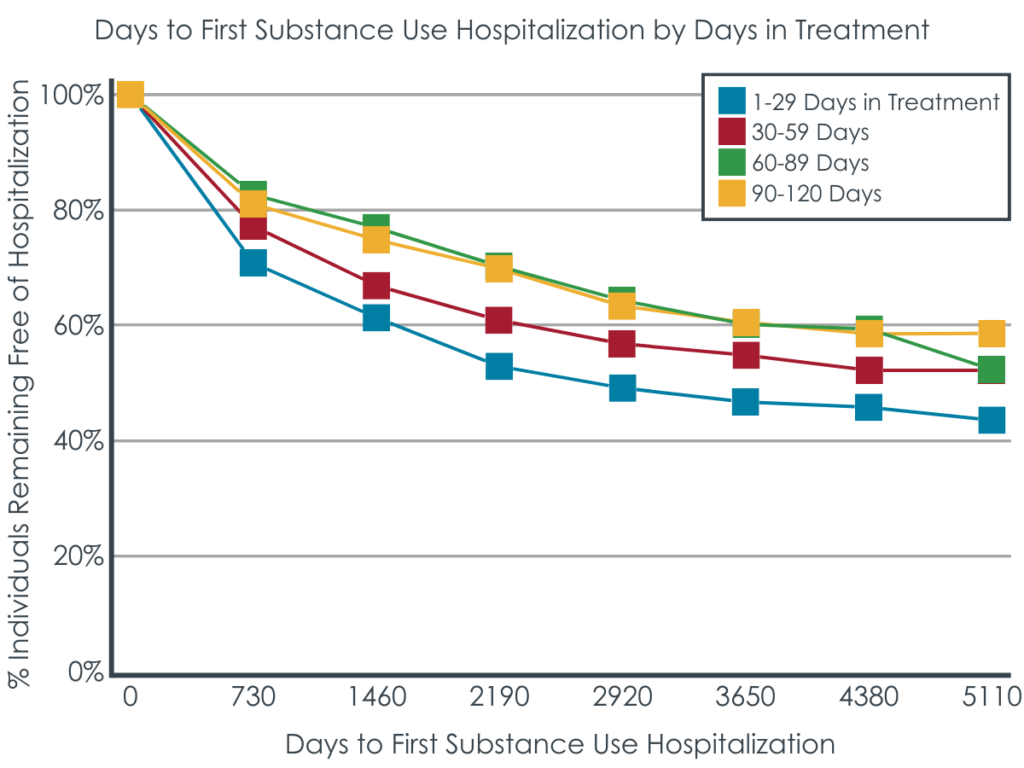Financial constraints and high demand for limited treatment space require programs to strike a balance between the most effective treatment that can be delivered over the shortest period of time. This study linked long-term data from a treatment program, the justice department, and hospitals to explore what length of stay is associated with reduced risk of crime as well as hospitalizations among youth who attended residential treatment.
WHAT PROBLEM DOES THIS STUDY ADDRESS?
Substance use during adolescence, specifically, is linked with higher lifetime arrest, more chronic arrests (90 arrests or more), and more arrests per year, which increases justice system costs. In the U.S. during 2020, the average state cost for the secure confinement of a young person was $588 per day, or $214,620 per year. Thus, connecting youth with substance use treatment may indirectly reduce criminal behavior and the high financial cost for the justice system even when that is not the goal.
Residential treatment has been found to improve substance use and criminal justice outcomes. However, fiscal constraints and the high demand for limited treatment space puts pressure on treatment planners to find a balance between the most efficient and effective duration of treatment. Yet, it is unclear what length of stay is needed to reduce the risk of future criminal convictions as well as substance-related hospitalizations. This study aimed to identify the ideal duration of stay at an adolescent residential treatment program that is associated with reduced risk of criminal offending and hospitalization in Sydney, Australia.
HOW WAS THIS STUDY CONDUCTED?
This study conducted a retrospective analysis with linked administrative databases from an adolescent residential treatment program, the New South Wales (i.e., Sydney, Australia) Bureau of Crime Statistics and Research Reoffending Database, and the New South Wales Admitted Patients Data Collection. The final sample of 1,993 clients were all admitted to the Ted Noffs Program for Adolescent Life Management (PALM) center, and client data were collected from January 1st, 2001, to December 31st, 2016.
The treatment program provides trauma-informed counseling and cognitive-behavior focused therapies, family support, group work, vocational and education opportunities, and recreational activities, and it aims to develop life and social skills in addition to substance use specific therapies. Referrals come from police and courts, health-care providers, family and friends, and self-referrals. Currently, the program advertises up to 3 months of residential treatment for young people aged 13-18 years old. The researchers in the study do not document the recommended length of treatment, how length of stay is generally determined, or why adolescents choose to exit the program. The key exposure variable was duration stay, which was calculated with the patient data and categorized as 1–29 days, 30–59 days, 60–89 days, and 90–120 days. An important limitation of this study is that adolescents were not randomized to receive these different lengths of stay. Thus, there are likely self-selection effects from unmeasured variables (e.g., personality, addiction severity, clinical complexity, recovery motivation) that influence findings.
The primary outcome of interest was the first post-program criminal conviction for any reason, and separately for a violent, nonviolent, and administrative offense. Violent offenses included crimes such as homicide, robbery, and extortion. Nonviolent offenses included crimes such as unlawful entry, and administrative offenses included things such as traffic and vehicle regulation offenses.
The secondary outcome of interest was hospitalization for substance use, which was identified from patients’ data via the Admitted Patients Data Collection. This data includes admitted patient diagnoses, procedures and services provided by public hospitals, public psychiatric hospitals, private hospitals, and day procedure centers. Clients were identified with a substance use disorder diagnosis if they had a primary or secondary diagnosis corresponding to a mental and behavioral disorder due to psychoactive substance use according to ICD-10AM codes, which are the International Classification of Diseases-Australian Modification codes used in medical diagnoses in Australia.
Administrative data regarding criminal justice and hospitalization outcomes were available from the day participants left the treatment program to their first criminal conviction (separately for any offense, violent offense, non-violent offense, and administrative offense), hospitalization for substance use, or the end of the observation period (December 31st, 2016), whichever came first. The post-treatment follow-up period ranged from 24 days to 15.98 years, with a median duration of 8.3 years. Analyses were then conducted that examined the association between duration of stay and rate of subsequent criminal conviction and hospitalization after accounting for other covariates. The covariates include gender, age at first referral, Aboriginal and/or Torres Strait Islander identity, socioeconomic disadvantage, prior mental health disorder diagnosis, number of prior criminal convictions, number of drugs of concern, referral from juvenile justice, and prior days in treatment at this program before this admission.
Of the 1,933 clients included in this study, 921 (46.2%) were in treatment for 1–29 days (median length of stay = 10 days), 425 (21.3%) were in treatment for 30–59 days (median = 44 days), 449 (22.5%) were in treatment for 60–89 days (median = 77 days) and 198 (9.9%) were in treatment for 90–120 days (median = 98 days). There were more men in all groups (64–78%), and the groups generally had less than half who identified as Aboriginal and/or Torres Strait Islander (33–50%). Those in the 1–29 day, 30–59 day, 6–89 day, and 90–120-day groups had 61%, 57%, 48%, and 54% of clients with a lifetime mental health disorder diagnosis prior to treatment, respectively. The average number of prior criminal convictions ranged from 2.9 to 4.6. Average age at first referral for all groups was 16, with 3 drugs of concern on average. Socioeconomic status was broken into quintiles, and the largest quintile for all groups was the most disadvantaged quintile, with 43-49% of clients falling in the most disadvantaged group.
WHAT DID THIS STUDY FIND?
More time in treatment associated with more days to first conviction and hospitalization.

Analyses indicated that the time to first conviction for any reason was shortest for those in treatment for the least amount of time (from 1–29 days) and was longer in each consecutive group. Median days to first conviction across the four groups were 371 days, 474 days, 699 days, and 1110 days. More days in treatment also reduced the probability of hospitalization for substance use, but treatment duration of 60 days or more did not appear to have additional benefit.

Figures 1 and 2. These data were reported as survival curves, which in this case does not indicate actual “survival,” but rather the amount of time someone went before being convicted or hospitalized. In both instances, the more time spent in treatment, the longer the participants went without being convicted or hospitalized, ending in roughly 40% and 50% respectively still being free of either negative outcome at 5110 days in the highest treatment condition.
Risk of criminal offense and hospitalization depends on duration of stay and type of crime.
In analyses that accounted for other key variables (e.g., prior convictions, mental health diagnosis), the rates of conviction for both any offense and a non-violent offense, as well as the rate of hospitalization, were greater for those who attended treatment for 30–59 days compared to 1–29 days. Reductions were seen again among the 60–89-day group compared to the 30–59-day group. There were no differences between the 60–89 day and 90–120-day groups for any offense, non-violent offense, or hospitalization. For a violent offense, the rate of re-conviction did not decrease until receipt of 60–89 days of treatment, relative to 1–29 days of treatment, and 90–120 days did not further decrease the rate of violent convictions compared to 60–89 days. Administrative offenses did not differ across durations of stay.
WHAT ARE THE IMPLICATIONS OF THE STUDY FINDINGS?
In this retrospective study, the researchers analyzed 15 years of administrative data from a residential adolescent treatment program, criminal justice records, and hospital records to explore the relationship between duration of stay and the rate of criminal convictions and hospitalizations. The study found that a duration of stay of 60–89 days was associated with reductions in risk of being convicted for any crime, violent crime, and non-violent as well as hospitalizations up to 15 years following treatment exit. Yet, 90–120 days in treatment was not linked with lower rates of convictions or hospitalizations, and 30–59 days was only beneficial for any offenses non-violent offense, and hospitalizations.
The high financial cost and time commitment for residential treatment are two significant barriers to attendance. Thus, a range of stakeholders including program staff, third party payers, and individuals and families could benefit from knowledge regarding the shortest possible treatment duration associated with benefit. Although this is not a randomized control trial, this study suggests that adolescents who attended this specific treatment program for 60–89 days were at reduced risk of being convicted of a criminal offense and hospitalized for substance use compared to those who attended treatment for less time. Although more research is needed to establish causal connections between length of stay and these kinds of outcomes, it may by that supporting and reimbursing residential treatment for at least 60 days could reduce criminal behavior and hospitalizations among a population with historically high rates of both, which could significantly reduce finical cost and pressure on the justice and medical systems. More work is needed to verify if these observed associations found in this study apply to places outside of Australia and this specific program.





